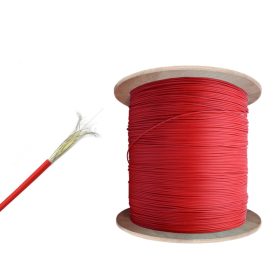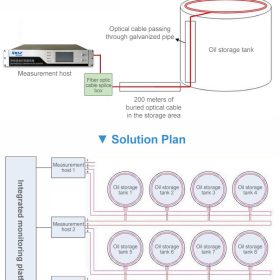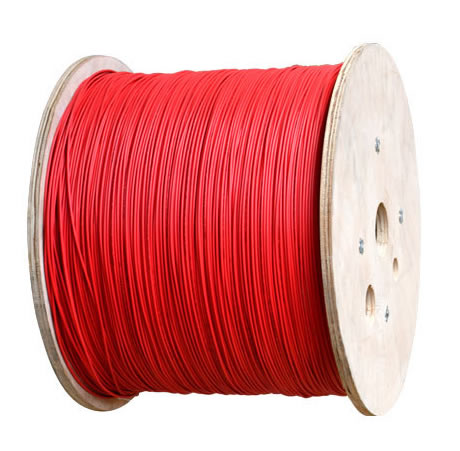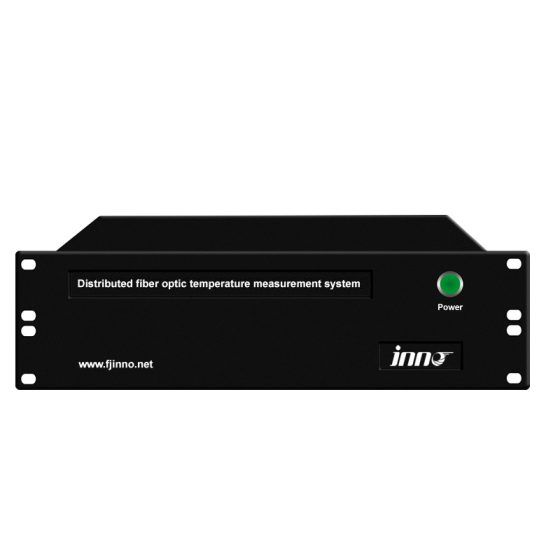China’s chemical storage tanks mainly use floating roof tanks and spherical tanks. The top of the floating roof oil tank adopts secondary sealing technology, but it is not completely sealed, and there is a possibility of a small amount of chemical liquid and gas leaking out of the sealing ring. These leaked gases are prone to fire under natural conditions such as high temperature in the sun and lightning strikes. The detection of fires is particularly important. Due to the outdoor location, large volume, and wide tank area of storage tanks, linear fire detectors are commonly used.

Advantages of Te mau tao'a e vai ra i roto i te mau uaua uira Temperature Measurement System for Oil Storage Tanks
(1) Sensors and optical cables not only serve as temperature detectors but also play an important role in signal transmission, integrating transmission and sensing. As there is no need to install additional sensing components, there is no fusion point in the middle of the sensing optical cable, resulting in high reliability.
(2) Continuous distributed measurement without measurement blind spots: DTS belongs to continuous distributed measurement and can obtain the temperature of each point along the sensing optical cable. I teie nei, the distance interval between adjacent temperature points can reach up to 0.25m, with rich temperature information and no measurement self zone. Hau atu â, based on continuous temperature analysis, regional temperature difference alarm can be achieved.
(3) Low workload for later operation and maintenance: DTS’s sensing optical cables are designed based on outdoor communication optical cables, and the service life of communication optical cables can reach up to 30 te mau matahiti; The core components of the DIS measurement host, such as light sources and splitters, are all communication grade devices with a designed lifespan of 100000 Te mau hora (more than 10 te mau matahiti). The host is equipped with a temperature calibration unit and a fault self check module, ensuring stable and reliable temperature measurement.
Software functions of distributed fiber optic temperature measurement system for oil storage tanks

Ia au i te mau huru opereraa o te mau vairaa mori arahu e te mau titauraa taa maitai no te hi'opoaraa i te anuvera, a “Hoê pereoo tura'i, hoê matini” mode is adopted for design. I te hoê â taime, no te faarahi i te vai-papû-raa o te faanahoraa, E fariihia te mau matini no te tata'i i te mau matini roro uira, o te nehenehe e taui taue noa ia ore ana'e te faanahoraa e manuïa. The fiber optic distributed temperature monitoring system monitors the required oil tanks in real-time online.
1) E hi'opoahia te pereoo pâ auri tataitahi e te hoê fibres tiamâ o te hi'o, tei tamauhia i ni'a i te mereti o te pereoo tura'i e i te hiti o te piti o te tape'a rima taatiraa.
2) The anti-static optical fiber led out by the te mau tumu ite o te anuvera o te titia mata installed on the floating plate inside the tank is protected by laying an explosion-proof metal hose inside the tank. The upper end of the explosion-proof metal hose is fixed on the flange plate of the manhole on the tank top, e ua tamauhia te hopea raro o te auri i nia i te mereti e painu ra i roto i te pereoo pâ auri. E ere te ravea tataîraa i te ohipa veavea, e ua taamuhia te auri turu i ni'a i te tino o te taata.
3) A hi'o na i te mau tauiraa i roto i te tapearaa i nia i te pereoo pâ auri e painu ra, no te arai i te mau fibres pato'i i te mata'i e tere ra na roto i te mau niuniu afa'ihia e te mau auri eiaha ia hee atu i ni'a i te pape, eiaha te roaraa o te taime ia iti mai i te 0.5 A faito i te teitei o te patu rapae o te pereoo, e e ti'a ia faaohipahia te hoê matini hamani titia mata no te hi'opo'a i te fibres pato'i i te mata'i i roto i te hoê vahi ti'araa.
4) The anti-static optical fiber led out by the fiber optic temperature sensor installed on the floating plate inside the tank is laid with explosion-proof galvanized pipes outside the tank and led along the escalator or tank wall to the existing cable tray on the ground. It is connected and protected with the communication optical cable installed inside the cable tray through a waterproof optical cable splice box, and the elbow part is connected with explosion-proof metal hoses.
5) E arata'ihia te mau matini atoa no te anuvera o te titia mata tei tamauhia i ni'a i te tapo'i fare o te mau vairaa mori arahu tata'itahi i roto i te vahi tape'araa pereoo, na roto i te mau niuniu hi'opo'a e te mau niuniu paraparau no te haapu'eraa e no te hapono atu i roto i te piha hi'opo'araa. Ua huna - roa - hia te niuniu paraparauraa, e ua taamuhia te poro rima i ni'a i te hoê tuio auri.
6) I muri a'e i te parareraa te niuniu paraparau mai te vahi o te pereoo pâ auri e tae atu i te piha hi'opoaraa, ua taaihia te reira i te ravea e itehia ' i te reni e tano i te DTS host na roto i te hoê aero poto noa o te titia mata e te hoê tuatiraa i rotopu i te mau tao'a tahi ora, o te hoê ïa ou'araa i ni'a i te taura.
7) A multi-channel DTS distributed fiber optic temperature measurement host is placed in the monitoring room to achieve temperature signal acquisition, Te mau mana'o tauturu no te haapiiraa, I ni'a i te tapo'i o te anuv, Te mau mana'o tauturu no te, e te mau faanahoraa no te faatereraa i te mau haamaramaramaraa no te mau tao'a no te anuvera o te titia mata tei haamauhia i ni'a i te vahi tape'araa mori arahu. It can be connected to the fire alarm control system through the switch alarm interface to achieve fire alarm and display it in the fire duty room. Te faufaa o te anuvera i teie nei, Ti'araa pĭpĭ, e e nehenehe te anuvera o te mau anuvera atoa o te anuvera e itehia i roto i te piha o te vairaa tauihaa na roto i te hoho'a fenua o te porotarama roro uira o te porotarama roro uira. An external sound and light alarm can also be connected to the instrument operation room to provide alarm signals.
 Te mau matini no te anuvera i roto i te mau matini roro uira ,te mau faanahoraa no te hi'opo'araa i te anuvera.
Te mau matini no te anuvera i roto i te mau matini roro uira ,te mau faanahoraa no te hi'opo'araa i te anuvera.






